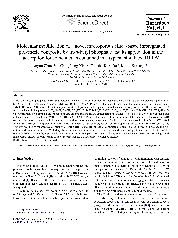摘要
Using tri-n-butyl phosphate (TBP) as a molecular modifier, a novel macroporous silica-based 4,4',(5')-di-(tert-butylcyclohexano)-18-crown-6 (DtBuCH18C6) polymeric composite (DtBuCH18C6+TBP/SiO2-P) was synthesized. It was done by impregnating and immobilizing DtBuCH18C6 and TBP molecules into the pores of SiO2-P particles utilizing an advanced vacuum sucking technique. The adsorption of 10 fission and non-fission products Sr(II), Ba(II), Ru(III), Mo(VI), Na(I), K(I), Pd(II), La(III), Cs(I), and Y(III) onto (DtBuCH18C6 + TBP)/SiO2-P was investigated by examining the influence of contact time and the HNO3 concentration in a range of 0.1-5.0 M at 298 K. It was found that at the optimum concentration of 2.0M HNO3 (DtBuCH18C6+TBP)/SiO2-P exhibited strong adsorption ability and high selectivity for Sr(II) over all of the tested elements, which showed very weak or almost no adsorption except Ba(II). Moreover, the quantity of DtBuCH18C6 leaked from (DtBuCH18C6+TBP)/SiO2-P in 2.0M HNO3, 326.2ppm, was obviously lower than 658.4ppm that leaked from DtBuCH18C6/SiO2-P. This was ascribed to the effective association of DtBuCH18C6 and TBP through intermolecular interaction, i.e., hydrogen bonding. The significant reduction of DtBuCH18C6 leakage by molecular modification with TBP was achieved. It was of great benefit to application of the (DtBuCH18C6+TBP)/SiO2-P polymeric composite in chromatographic partitioning of Sr(II), one of the main heat generators, from high level liquid waste (HLLW) in reprocessing of nuclear spent fuel in MAREC process developed recently.
- 出版日期2007-8-17
- 单位浙江大学
